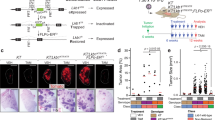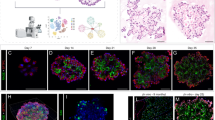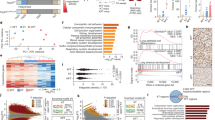Abstract
Stem cell function is central for the maintenance of normal tissue homeostasis. Here we show that deletion of p38α mitogen-activated protein (MAP) kinase in adult mice results in increased proliferation and defective differentiation of lung stem and progenitor cells both in vivo and in vitro. We found that p38α positively regulates factors such as CCAAT/enhancer-binding protein that are required for lung cell differentiation. In addition, p38α controls self-renewal of the lung stem and progenitor cell population by inhibiting proliferation-inducing signals, most notably epidermal growth factor receptor. As a consequence, the inactivation of p38α leads to an immature and hyperproliferative lung epithelium that is highly sensitized to K-RasG12V-induced tumorigenesis. Our results indicate that by coordinating proliferation and differentiation signals in lung stem and progenitor cells, p38α has a key role in the regulation of lung cell renewal and tumorigenesis.
This is a preview of subscription content, access via your institution
Access options
Subscribe to this journal
Receive 12 print issues and online access
$209.00 per year
only $17.42 per issue
Buy this article
- Purchase on Springer Link
- Instant access to full article PDF
Prices may be subject to local taxes which are calculated during checkout








Similar content being viewed by others
References
Fuchs, E., Tumbar, T. & Guasch, G. Socializing with the neighbors: stem cells and their niche. Cell 116, 769–778 (2004).
Rawlins, E.L. & Hogan, B.L. Epithelial stem cells of the lung: privileged few or opportunities for many? Development 133, 2455–2465 (2006).
Kim, C.F. et al. Identification of bronchioalveolar stem cells in normal lung and lung cancer. Cell 121, 823–835 (2005).
Nebreda, A.R. & Porras, A. p38 MAP kinases: beyond the stress response. Trends Biochem. Sci. 25, 257–260 (2000).
Ono, K. & Han, J. The p38 signal transduction pathway: activation and function. Cell. Signal. 12, 1–13 (2000).
Adams, R.H. et al. Essential role of p38alpha MAP kinase in placental but not embryonic cardiovascular development. Mol. Cell 6, 109–116 (2000).
Allen, M. et al. Deficiency of the stress kinase p38alpha results in embryonic lethality: characterization of the kinase dependence of stress responses of enzyme-deficient embryonic stem cells. J. Exp. Med. 191, 859–870 (2000).
Mudgett, J.S. et al. Essential role for p38alpha mitogen-activated protein kinase in placental angiogenesis. Proc. Natl. Acad. Sci. USA 97, 10454–10459 (2000).
Tamura, K. et al. Requirement for p38alpha in erythropoietin expression: a role for stress kinases in erythropoiesis. Cell 102, 221–231 (2000).
Craxton, A. et al. p38 MAPK is required for CD40-induced gene expression and proliferation in B lymphocytes. J. Immunol. 161, 3225–3236 (1998).
Engel, F.B. et al. p38 MAP kinase inhibition enables proliferation of adult mammalian cardiomyocytes. Genes Dev. 19, 1175–1187 (2005).
Engelman, J.A., Lisanti, M.P. & Scherer, P.E. Specific inhibitors of p38 mitogen-activated protein kinase block 3T3–L1 adipogenesis. J. Biol. Chem. 273, 32111–32120 (1998).
Lluis, F., Perdiguero, E., Nebreda, A.R. & Munoz-Canoves, P. Regulation of skeletal muscle gene expression by p38 MAP kinases. Trends Cell Biol. 16, 36–44 (2006).
Morooka, T. & Nishida, E. Requirement of p38 mitogen-activated protein kinase for neuronal differentiation in PC12 cells. J. Biol. Chem. 273, 24285–24288 (1998).
Guerra, C. et al. Tumor induction by an endogenous K-ras oncogene is highly dependent on cellular context. Cancer Cell 4, 111–120 (2003).
Wang, N.D. et al. Impaired energy homeostasis in C/EBP alpha knockout mice. Science 269, 1108–1112 (1995).
Martis, P.C. et al. C/EBPalpha is required for lung maturation at birth. Development 133, 1155–1164 (2006).
Basseres, D.S. et al. Respiratory failure due to differentiation arrest and expansion of alveolar cells following lung-specific loss of the transcription factor C/EBPalpha in mice. Mol. Cell. Biol. 26, 1109–1123 (2006).
Halmos, B. et al. A transcriptional profiling study of CCAAT/enhancer binding protein targets identifies hepatocyte nuclear factor 3 beta as a novel tumor suppressor in lung cancer. Cancer Res. 64, 4137–4147 (2004).
Ambrosino, C. et al. TEF-1 and C/EBPbeta are major p38alpha MAPK-regulated transcription factors in proliferating cardiomyocytes. Biochem. J. 396, 163–172 (2006).
Tang, Q.Q. et al. Sequential phosphorylation of CCAAT enhancer-binding protein beta by MAPK and glycogen synthase kinase 3beta is required for adipogenesis. Proc. Natl. Acad. Sci. USA 102, 9766–9771 (2005).
Chen, J., Kunos, G. & Gao, B. Ethanol rapidly inhibits IL-6-activated STAT3 and C/EBP mRNA expression in freshly isolated rat hepatocytes. FEBS Lett. 457, 162–168 (1999).
Deng, J., Hua, K., Caveney, E.J., Takahashi, N. & Harp, J.B. Protein inhibitor of activated STAT3 inhibits adipogenic gene expression. Biochem. Biophys. Res. Commun. 339, 923–931 (2006).
Lavoie, J.N., L'Allemain, G., Brunet, A., Muller, R. & Pouyssegur, J. Cyclin D1 expression is regulated positively by the p42/p44MAPK and negatively by the p38/HOGMAPK pathway. J. Biol. Chem. 271, 20608–20616 (1996).
Casanovas, O. et al. Osmotic stress regulates the stability of cyclin D1 in a p38SAPK2-dependent manner. J. Biol. Chem. 275, 35091–35097 (2000).
DaSilva, J., Xu, L., Kim, H.J., Miller, W.T. & Bar-Sagi, D. Regulation of sprouty stability by Mnk1-dependent phosphorylation. Mol. Cell. Biol. 26, 1898–1907 (2006).
Mailleux, A.A. et al. Evidence that SPROUTY2 functions as an inhibitor of mouse embryonic lung growth and morphogenesis. Mech. Dev. 102, 81–94 (2001).
Mialon, A. et al. DNA topoisomerase I is a cofactor for c-Jun in the regulation of epidermal growth factor receptor expression and cancer cell proliferation. Mol. Cell. Biol. 25, 5040–5051 (2005).
Jackson, E.L. et al. Analysis of lung tumor initiation and progression using conditional expression of oncogenic K-ras. Genes Dev. 15, 3243–3248 (2001).
Sibilia, M. et al. The EGF receptor provides an essential survival signal for SOS-dependent skin tumor development. Cell 102, 211–220 (2000).
Bardeesy, N. et al. Role of epidermal growth factor receptor signaling in RAS-driven melanoma. Mol. Cell. Biol. 25, 4176–4188 (2005).
Pirrotta, V. & van Lohuizen, M. Differentiation and gene regulation Genomic programs and differentiation. Curr. Opin. Genet. Dev. 16, 443–446 (2006).
Nystul, T.G. & Spradling, A.C. Breaking out of the mold: diversity within adult stem cells and their niches. Curr. Opin. Genet. Dev. 16, 463–468 (2006).
Benitah, S.A., Frye, M., Glogauer, M. & Watt, F.M. Stem cell depletion through epidermal deletion of Rac1. Science 309, 933–935 (2005).
Li, L. & Xie, T. Stem cell niche: structure and function. Annu. Rev. Cell Dev. Biol. 21, 605–631 (2005).
Cheng, L.C., Tavazoie, M. & Doetsch, F. Stem cells: from epigenetics to microRNAs. Neuron 46, 363–367 (2005).
Adams, G.B. & Scadden, D.T. The hematopoietic stem cell in its place. Nat. Immunol. 7, 333–337 (2006).
Lawson, G.W. et al. Mouse strain modulates the role of the ciliated cell in acute tracheobronchial airway injury-distal airways. Am. J. Pathol. 160, 315–327 (2002).
Sugahara, K. et al. Mice lacking CCAAt/enhancer-binding protein-alpha show hyperproliferation of alveolar type II cells and increased surfactant protein mRNAs. Cell Tissue Res. 306, 57–63 (2001).
Johnson, L. et al. Somatic activation of the K-ras oncogene causes early onset lung cancer in mice. Nature 410, 1111–1116 (2001).
Meuwissen, R., Linn, S.C., van der Valk, M., Mooi, W.J. & Berns, A. Mouse model for lung tumorigenesis through Cre/lox controlled sporadic activation of the K-Ras oncogene. Oncogene 20, 6551–6558 (2001).
Bulavin, D.V. & Fornace, A.J., Jr. p38 MAP kinase's emerging role as a tumor suppressor. Adv. Cancer Res. 92, 95–118 (2004).
Coe, B.P. et al. Differential disruption of cell cycle pathways in small cell and non-small cell lung cancer. Br. J. Cancer 94, 1927–1935 (2006).
Xie, H., Ye, M., Feng, R. & Graf, T. Stepwise reprogramming of B cells into macrophages. Cell 117, 663–676 (2004).
Ventura, J.J. et al. Chemical genetic analysis of the time course of signal transduction by JNK. Mol. Cell 21, 701–710 (2006).
Livak, K.J. & Schmittgen, T.D. Analysis of relative gene expression data using real-time quantitative PCR and the 2(-delta delta C(T)) method. Methods 25, 402–408 (2001).
Acknowledgements
The targeting vector was generated while E.P. and A.R.N. were working at the EMBL (Heidelberg). We are grateful to M. Morente and the CNIO Tumor Bank Network for providing human samples of tumoral and normal lungs and T. Graf (CRG) for the C/EBPα expression construct. We thank A. Garcia and J. Sanchez for technical help with the mouse colony and histological work, respectively. J.J.V. is an investigator of the Ramon y Cajal Programme. This work was funded by grants to A.R.N. from the Spanish Ministerio de Educación y Ciencia, Marató-TV3 and the Fundación Científica de la Asociación Española Contra el Cáncer.
Author information
Authors and Affiliations
Contributions
J.J.V. and A.R.N. designed the research; J.J.V. performed the research; S.T. provided technical support and managed the mouse colony; E.P. generated the p38α targeting vector; C.G. and M.B. contributed essential tools and advice; M.H. and M.P. generated the p38α floxed mice; J.J.V. and A.R.N. interpreted the results and wrote the paper.
Corresponding authors
Ethics declarations
Competing interests
The authors declare no competing financial interests.
Supplementary information
Supplementary Fig. 1
Biochemical changes in lungs from p38α-deficient mice. (PDF 193 kb)
Supplementary Fig. 2
Isolation and characterization of lung stem and progenitor cells. (PDF 274 kb)
Supplementary Fig. 3
Histological analysis of K-RasG12V-induced tumorigenesis in p38α-deficient lungs. (PDF 860 kb)
Supplementary Table 1
RT-PCR primer sequences. (PDF 39 kb)
Rights and permissions
About this article
Cite this article
Ventura, J., Tenbaum, S., Perdiguero, E. et al. p38α MAP kinase is essential in lung stem and progenitor cell proliferation and differentiation. Nat Genet 39, 750–758 (2007). https://doi.org/10.1038/ng2037
Received:
Accepted:
Published:
Issue Date:
DOI: https://doi.org/10.1038/ng2037
This article is cited by
-
Diversity and versatility of p38 kinase signalling in health and disease
Nature Reviews Molecular Cell Biology (2021)
-
The deubiquitinase USP16 functions as an oncogenic factor in K-RAS-driven lung tumorigenesis
Oncogene (2021)
-
A novel function of IMPA2, plays a tumor-promoting role in cervical cancer
Cell Death & Disease (2020)
-
WIP1 promotes cancer stem cell properties by inhibiting p38 MAPK in NSCLC
Signal Transduction and Targeted Therapy (2020)
-
Chlorella vulgaris modulates the expression of senescence-associated genes in replicative senescence of human diploid fibroblasts
Molecular Biology Reports (2020)



